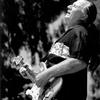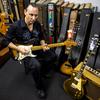zzero

Joined: Jul 09, 2010
Posts: 1153
Lillian Alabama


|

Posted on Sep 27 2014 04:15 PM
Well, it was. I was there in Pensacola in April. First time I had seen or heard a Quilter in the flesh. I was really impressed with it. 
Obviously Dick could have cranked his rig up. Edwin's Quilter was like a violin cutting thru an orchestra. One moron's opinion. 
— Enjoying the surf,sun and sand!!
Last edited: Sep 27, 2014 16:22:18
|
JohnnyMosrite

Joined: Jun 14, 2006
Posts: 911
New York City area
|

Posted on Sep 27 2014 05:22 PM
ZZero,
According to you - "No one on this forum remembers the first tube amps--they were nasty little things". Broad (inaccurate) generalization there, zzero.
I beg to differ. I certainly remember them. I even built one - one of the old Heathkit TA-19 2x12 combos or whatever it was called. It was a glorified distortion box. But I learned a few things about electronics and a few things about economics - as in you generally get what you pay for.
Another SS amp I have is a Yamaha 4x12 stack with the GB-100 head. With a Mosrite, it closely mimics the "Ventures Live on Stage" Sound.
It's never given me a problem. Mike Stern uses a 2x12 combo version on the road. So it can't be all bad.
J Mo'
|
JohnnyMosrite

Joined: Jun 14, 2006
Posts: 911
New York City area
|

Posted on Sep 27 2014 05:25 PM
ZZero,
I also had an old Fender Deluxe and regret the day I sold it. I would call it a bit different from today's amps but not necessarily nasty.
J Mo'
|
zzero

Joined: Jul 09, 2010
Posts: 1153
Lillian Alabama


|

Posted on Sep 27 2014 08:02 PM
Ok. Electric guitars and their amplifiers were invented in the 1920's.
The designs were not perfected for years. Rickenbaker offered the first unit for commercial sale in what, 1931 I think. I was told by pro musicians that actually used 1930's tube amps that the first tube amps were nasty and unreliable. I was told this in the early 1970's by 60 and 70 year old pro players that actually used the first tube amps in the 1930's. First hand witnesses that used the things back in the day. Broad (inaccurate) generalization? I don't see it.
I had a late 1960's silverface Deluxe in the late 60's and early 70's.
Probably the best amp I ever had. Still regret the day I sold the burned out chassis and box. That was the 3RD time I blew it up.
What was the approximate birthday of your deluxe?
— Enjoying the surf,sun and sand!!
Last edited: Sep 27, 2014 23:37:06
|
zzero

Joined: Jul 09, 2010
Posts: 1153
Lillian Alabama


|

Posted on Sep 27 2014 11:33 PM
OK--I did some research on this. Ric's first electric and amp came out in 1931, not 1925 as I posted. the electromagnetic pickup was designed in 1925. So my timeline is 6 years off. Still...
I have corrected the dates in my previous post.
— Enjoying the surf,sun and sand!!
Last edited: Sep 27, 2014 23:39:29
|
PrestonRice

Joined: Oct 05, 2012
Posts: 1725
Austin, Texas


|

Posted on Sep 27 2014 11:47 PM
zzero wrote:
OK--I did some research on this. Ric's first electric and amp came out in 1931, not 1925 as I posted. the electromagnetic pickup was designed in 1925. So my timeline is 6 years off. Still...
Role count, how many of us were around in '31? I know I was...

In all seriousness, zzero makes a great point. Not that we didn't try some of the earliest amps - But that they really kind of sucked, and really didn't get much better until the fifties or sixties. Thing is, those amps are not "good" by today's standards - A lot of people are just stuck on the oldschool sounds because that's what sounds good to them - And that's totally okay! I will admit there's something very special about blasting open chords through an old showman.
However, there is something much more special about low B djenting and dissonant harmonics through a good rack mounted amp modeler. 
— IMO.
Last edited: Sep 27, 2014 23:47:47
|
tubeswell

Joined: Sep 24, 2011
Posts: 1424
Wellington, NZ






|

Posted on Sep 28 2014 12:02 AM
Richard wrote:
"The purpose of an amplifier is to reproduce a signal as accurately as possible but with a higher "output" amplitude than "input." Thus, if an amplifier is well-designed, it should make no difference whether it uses tubes or transistors, so long as it is operating in it's linear range. In guitar parlance, this is referred to as a "clean" tone. The tubes and transistors serve essentially the same purpose in either case. It is only when the amplifier is operating outside it's linear range that tubes behave differently from transistors, that is when the amplifier is "over-driven." In most areas of music reproduction, this situation is avoided, as it means that the signal will be distorted. The distortion takes the form of "clipping" - the wave-form above a certain amplifier will be chopped off. Tubes do this clipping differently than transistors, producing a "softer," asymmetrical clipping and favouring even-order harmonics over odd-order. This "softer" clipping makes sense, as a tube operates using electrons in a glass tube - there is a lot of space for extra electrons to collect. The clipping produced by tubes is more pleasing to the human ear and at some point, electric guitarist decided that they liked this sound. By contrast, the clipping produced by transistors is "hard." Everything is chopped off equally."
This makes me wonder if what we all like the most about our tube amps is a happy accident. Wasn't Leo Fender using the available technology at the time to try to reproduce the sound of the guitar more loudly without distortion?
No its not a happy accident. Tube amplification is mainly non-linear - that is to say that the signal swing at the plate is not an amplified 'mirror image' of the signal swing at the the signal grid, rather the swing (at the plate) is assymetrical; one side of the signal swing is bigger than the other side. This is what produces the harmonic distortion (or 'chimeyness') in tubes.
See graphic of non-linear amplification on a 12AX7 load line:
(In this image the grid voltage swings 2V up and down - either side of the grid voltage bias point, but the plate voltage swings 130V down from the corresponding plate voltage idle point, but only 75V up from the same point. This is what is meant by non-linearity)
https://flic.kr/p/p9fJSn
— He who dies with the most tubes... wins
Surf Daddies
Last edited: Sep 28, 2014 00:50:19
|
tubeswell

Joined: Sep 24, 2011
Posts: 1424
Wellington, NZ






|

Posted on Sep 28 2014 12:32 AM
zzero wrote:
Yes sir, that is exactly what Leo was doing. He was using the technology available at the time--his time.
My question is why is soft tube clipping more pleasing to the human ear. is it a learned behavior?? or a natural behavior? Why do some people prefer hard clipping? Who decided that soft clipping was preferable to
hard clipping? Just asking! 
By 'soft-clipping' they mean that the onset of clipping in a tube is gradual (whereas the onset of clipping in a transistor is abrupt. The abrupt clipping tends to produce harsh 'gritty' noises in the overdriven signal of a transistor). See images below for tube clipping
Plate clipping
https://flic.kr/p/p9g3rw
Grid current clipping
https://flic.kr/p/pqKP8Z
Transistor clipping (entry to, and exit from, clipping is sharp with faint jagged peaks at the transition point, resulting in an instantaneous and unmusical gritty overtone during overdriven conditions)

— He who dies with the most tubes... wins
Surf Daddies
Last edited: Sep 28, 2014 01:06:54
|
LeeVanCleef

Joined: Oct 05, 2011
Posts: 744
France


|

Posted on Sep 28 2014 04:06 AM
JohnnyMosrite wrote:
Another SS amp I have is a Yamaha 4x12 stack with the GB-100 head. With a Mosrite, it closely mimics the "Ventures Live on Stage" Sound.
It's never given me a problem. Mike Stern uses a 2x12 combo version on the road. So it can't be all bad.
These old SS Yamahas are truly awesome. They're built like tanks and sound fantastic clean. They blow a good number of modern tube amps out of the water in my opinion. They're the pinnacle of solid state amplification.
— Old punks never die... They just become surf rockers.
|
Surf_Skater

Joined: Sep 06, 2012
Posts: 1300
Lawrenceville , GA


|

Posted on Sep 28 2014 09:29 AM
LeeVanCleef wrote:
JohnnyMosrite wrote:
Another SS amp I have is a Yamaha 4x12 stack with the GB-100 head. With a Mosrite, it closely mimics the "Ventures Live on Stage" Sound.
It's never given me a problem. Mike Stern uses a 2x12 combo version on the road. So it can't be all bad.
These old SS Yamahas are truly awesome. They're built like tanks and sound fantastic clean. They blow a good number of modern tube amps out of the water in my opinion. They're the pinnacle of solid state amplification.
A friend of mine was just lamenting the other day about selling his old Yamaha 2x12 combo.
I think all this comes down to supply and demand. Most guitarists want vintage tube sound, so most manufacturers are going to make tube amps( I'm referring to the higher end of amps.).
Roland, Yamaha and Ampeg have made some pretty good SS's. But most people with 800 bucks and up in their pockets are going to buy tubes.
Quilter has definitely upped the ante in solid state though.
For someone like Surfer Joe that plays with a lot of other bands. You can put a Quilter block and a Topanga in a backpack, grab your Jazzmaster and hop the train to anywhere in Europe. As long as there is a cab to plug into when you get there.
The downside I see of high end SS is, if it breaks it's a lot harder to find a tech to fix it.
|
zzero

Joined: Jul 09, 2010
Posts: 1153
Lillian Alabama


|

Posted on Sep 28 2014 04:04 PM
Tubeswell--my questions weren't technical, they were cultural. I'm not an engineer and to your credit you are!
Why is soft clipping preferable to hard clipping? Is it a learned (as in cultural) response or a natural response? I think it is a learned response. Soft clipping was around well before hard clipping. It became accepted and expected. Hard clipping came later. The acceptance of soft clipping would have to be undone. What if soft clipping amps never existed? Hard clipping amps would be the accepted and expected sound. One culture's view of "musical sound" isn't necessarily another culture's view. I'm just saying.

— Enjoying the surf,sun and sand!!
|
zzero

Joined: Jul 09, 2010
Posts: 1153
Lillian Alabama


|

Posted on Sep 28 2014 04:09 PM
Surfskater--dude, you are so right about getting a SS amp repaired. You can't find many repairmen trained or willing to work on SS. SS is starting to mean "disposable". 
— Enjoying the surf,sun and sand!!
|
PrestonRice

Joined: Oct 05, 2012
Posts: 1725
Austin, Texas


|

Posted on Sep 28 2014 04:33 PM
zzero wrote:
One culture's view of "musical sound" isn't necessarily another culture's view. I'm just saying.
So true. What I find to be some tasty music:
https://www.youtube.com/watch?v=da4Tsnc6m5U
May not be considered musical by you silly old people. 
— IMO.
|
zzero

Joined: Jul 09, 2010
Posts: 1153
Lillian Alabama


|

Posted on Sep 28 2014 05:27 PM
Cool! reminds me of King Crimsom 
— Enjoying the surf,sun and sand!!
|
PrestonRice

Joined: Oct 05, 2012
Posts: 1725
Austin, Texas


|

Posted on Sep 28 2014 05:32 PM
Glad you like it! Bulb is a cool guitarist. It's stock as fuck up until about 1:54, but then it gets so tasty... That riff in 7 is just fantastic.
— IMO.
|
PrestonRice

Joined: Oct 05, 2012
Posts: 1725
Austin, Texas


|

Posted on Sep 28 2014 05:40 PM
Just found and uploaded a similar riff I did at one point:
https://soundcloud.com/thekidforever/enamor-wip
Comes at about 1:14.
Edit: Wow, this is bad! This was the first version I sent to my bandmate for help with the writing? Just an mp3, but this was before I had done any mixing at all, lol, and only a little bit of it was written. I'll need to find the Garageband file and upload it later on so it's slightly more bearable, haha.
— IMO.
Last edited: Sep 28, 2014 17:57:38
|
simoncoil

Joined: Sep 28, 2012
Posts: 926
Berlin, Germany





|

Posted on Sep 29 2014 03:57 AM
Okay guys, let me stir the pot a little. 
A while ago some guy on a German guitar forum took the effort to conceive a blindfold test for tube and soild state amps. He took two of each, send them through the same cabinet and miked and recorded them with the same settings. The guitar was pre-recorded on a looper that was then put in front of each amp, so that it is actually alway the very same played one each sample.
The amps featured were:
Rath Retro 20 (solid state)
Peacey Bandit (solid state)
Marshall Clas 5 (tube)
Marshall JVM (tube)
This is of course NOT the order in the test! You can listen to the samples on the youtube video below and can try to identify the amps (good luck  ). And more important: Decide which one you like best. The solution can be read in the extended version of the video description. ). And more important: Decide which one you like best. The solution can be read in the extended version of the video description.
When it was first posted, we we're of course not told, which amp was which, but I can tell you never the less, how we voted:
Amp 1: 24 %
Amp 2: 36 %
Amp 3: 21 %
Amp 4: 18 %
— Los Apollos - cinematic surf music trio (Berlin)
"Postcards from the Scrapyard" Vol. 1, 2 & 3 NOW available on various platforms!
"Chaos at the Lobster Lounge" available as LP and download on Surf Cookie Records!
|
Surfersaurus

Joined: Feb 10, 2010
Posts: 352
Australia


|

Posted on Sep 29 2014 09:12 AM
Real amps and 'fake' amps both have their place. They are two different instruments.
|
PrestonRice

Joined: Oct 05, 2012
Posts: 1725
Austin, Texas


|

Posted on Sep 29 2014 09:44 AM
Simoncoil - Very nice! I think the majority of differences in sound with such gear is how we hear it in person, too, which is important - The gear we enjoy can definitely play a hand in inspiring us to write and play more often, kind of what I've realized about really nice guitars as well. Still, he does prove a good point - To most people, one sound from one amp will sound very similar to the same sound from another amp.
— IMO.
|
Ariel

Joined: Aug 29, 2009
Posts: 1556
Israel






|

Posted on Sep 29 2014 12:16 PM
Blind tests like that are so deceiving, (same goes for many audio related issues), they'll give you no more than an impression, if it's in the ballpark or not.
Compressed audio is NEVER acceptable for comparison. Not to mention the rest of the audio chain at the listener side.
IMHO the real and only test for any equipment would be to play it like it was intended, in the same context that it was meant to be used.
No other way to get the feel of the device, the response to dynamics, the subtle compression/clipping, which in turn affects the emotional impact, the way you approach to playing it, and eventually the liveliness of the result.
A good example of that would be digital amp modeling. Even 10 years ago, the demos sounded great. A/B tests seem almost identical. It has improved immensely since then. So then again, why do I feel like crying whenever my guitar signal get translated to 01100001111100111001100110111001110000111100111100111011? *even with 1ms latency.)
Anyway, nothing against SS as a principle. I'd also love to try a Quilter.
|
![]()
![]()

















 ). And more important: Decide which one you like best. The solution can be read in the extended version of the video description.
). And more important: Decide which one you like best. The solution can be read in the extended version of the video description.





















